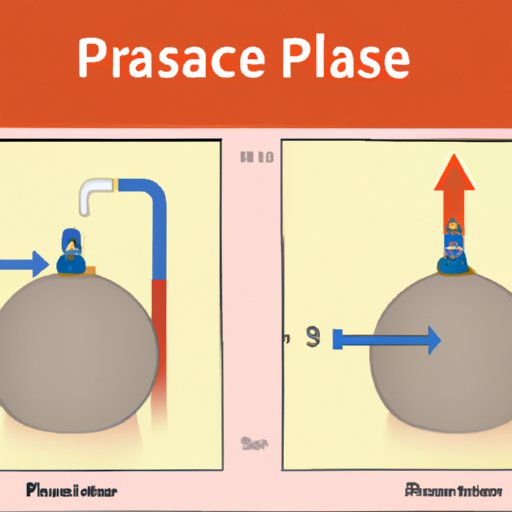
I. Introduction
Understanding partial pressure is critical for scientists in various fields, such as chemistry, physics, and engineering. This concept is used to describe the pressure of a single gas in a mixture of gases and plays a crucial role in determining the behavior of gases in diverse applications. Therefore, in this article, we will explore how to calculate partial pressure, and the importance of this concept in various professional fields.
II. A Step-by-Step Guide to Calculating Partial Pressure for Beginners
Partial pressure is the pressure exerted by each gas present in a mixture of gases. The total pressure of a gas mixture can be calculated by adding the partial pressures of all the gases present in the mixture. To calculate the partial pressure of a gas, use the formula:
Partial Pressure = Total Pressure x Mole Fraction
Where the mole fraction represents the number of moles of a specific gas within a mixture divided by the total number of moles in the mixture.
For example, if you have a mixture of carbon dioxide and nitrogen gases with a total pressure of 10 atm, and the mixture contains 0.2 moles of carbon dioxide and 0.8 moles of nitrogen, you can calculate the partial pressure of carbon dioxide using the formula:
Partial Pressure CO2 = 10 atm x 0.2/1 (total moles)
Partial Pressure CO2 = 2 atm
Therefore, in this section, we will guide the audience on how to calculate partial pressure using the formula above. We will also provide simple examples to help understand how partial pressure calculation works.
III. Understanding Partial Pressure: How to Calculate it Using the Ideal Gas Law
The Ideal Gas Law is a fundamental equation used to describe the behavior of ideal gases. This equation combines the basic concepts of gas laws, such as Charles’s Law, Boyle’s Law, and Avogadro’s Law into one equation.
The ideal gas law can be represented as follows:
PV = nRT
Where P = pressure, V = volume, n = number of moles, R = Universal Gas Constant, and T = temperature measured in Kelvin.
Using the ideal gas law, we can calculate the partial pressure of each gas in a mixture. The partial pressure can be calculated using the following formula:
Partial Pressure (P1) = Pressure (P) x Mole Fraction (n1/nTotal)
Where P1 is the partial pressure of the first gas, P is the total pressure of all gases in the mixture, and n1 is the number of moles of the first gas.
In this section, we will show how to use the Ideal Gas Law to calculate the partial pressure of a gas. We will also provide examples to help understand how the ideal gas law works in partial pressure calculations.
IV. Mastering Partial Pressure Calculation: Tips and Tricks
Calculating partial pressure accurately can be challenging, especially when working with complex gas mixtures. Therefore, we have generated some tips and tricks that can help you master partial pressure calculations. Some of the tips and tricks include:
1. Proper measurements: To obtain accurate partial pressure results, you should ensure that measurement tools such as thermometers and barometers are calibrated correctly, and measurements are taken correctly.
2. Dealing with non-ideal mixture: In some cases, gases do not react ideally, and so, partial pressure calculations may not be accurate. In such instances, a more sophisticated equation, Van der Waals’ equation, can be used to make the necessary corrections.
3. Advanced Calculations: For complex gas mixtures and non-equilibrium systems, advanced calculation methods such as Monte Carlo simulations can be used. Monte Carlo simulations use probability distributions to model the probabilities of several outcomes.
This section will provide the audience with helpful tips and tricks on how to calculate partial pressure accurately, especially for complex gas mixtures.
V. From Theory to Practice: Applying Partial Pressure Calculations in Real-Life Situations
Partial pressure calculations find their applications in a wide range of fields. For instance, scientists and engineers in the gas and oil industry use partial pressure calculations to understand how gases behave in refineries and pipelines. Scientists studying atmospheric chemistry use partial pressure calculations to monitor trace gases, such as ozone. Additionally, partial pressure calculations are essential in the manufacturing of electronic components, such as semiconductors.
In this section, we will discuss the use of partial pressure calculations in various industries and provide examples of how this concept helps solve practical problems.
VI. Why Partial Pressure Matters and How to Calculate It: An In-Depth Analysis
Partial pressure is a vital concept that matters in different professional fields, including environmental science, gas and oil industry, and manufacturing. Understanding partial pressure helps scientists and engineers make informed decisions on the design and operation of systems that involve gases.
Furthermore, partial pressure plays a significant role in lawmaking and safety regulation. For instance, the partial pressure of carbon dioxide is vital in determining acceptable levels of emissions from fossil fuels. Governments use the information to create regulations aimed at reducing greenhouse gas emissions and protecting the planet.
Additionally, recent advancements in partial pressure calculation technology, such as Monte Carlo simulations, have significantly improved the accuracy of partial pressure calculations.
In this section, we will discuss the importance of partial pressure calculations in various fields and how new technology is enhancing the accuracy of these calculations.
VII. Conclusion
Overall, understanding partial pressure is critical for anyone working with gas mixtures. This article has explored how to calculate partial pressure and why it is an essential concept in various industries. We hope that by reading this article, you will have a better grasp of partial pressure calculations and have the confidence to use the formula in real-life situations.
Remember, to master partial pressure calculations, it is essential to take accurate measurements, deal with non-ideal gas mixtures, and use advanced calculation methods when necessary.




